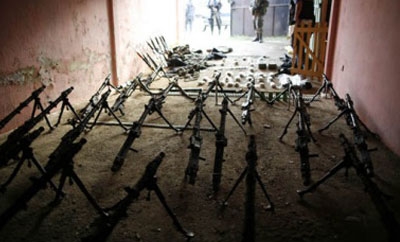A new report sheds light on a little-studied subject: the trafficking of US weapons into Guatemala, a relatively limited phenomenon that could be far bigger than suggested by the available data and may play a role in the continuing violence and criminality in that Central American nation.
The report (pdf), from the Woodrow Wilson International Center for Scholars, reviews an analysis that the US Bureau of Alcohol, Tobacco, Firearms and Explosives (ATF) conducted of weapons from two Guatemalan military bunkers in 2009. One bunker contained firearms and the other explosives and military ordnance.
Using the ATF’s Firearm Tracing System, which can track US-made guns back to their original manufacturer, officials found that 40 percent of the firearms from the bunker are linked to the US. Combined with a few other firearm trace requests previously submitted by the Guatemalan government, 1,687 of the 6,000 firearms analyzed — 28 percent — had been directly imported from the US.
In one noteworthy case, two pistols found at the scene of an apparent attack by the Mexican criminal group, the Zetas, in 2008, in which 11 members of a rival organization were killed including the rival leader, were traced back to a Texas gun store.
Of the explosives and military ordnance examined, the ATF estimated that nearly 85 percent could be traced back to the Guatemalan military itself. However, 46 of 762 items were of US origin, including hand grenades and an anti-tank rocket.
ATF sources told the report’s author, Colby Goodman, that traffickers importing US arms into Guatemala used two main routes: they hid the guns amongst other items in shipping boxes traveling overland through Mexico; or packed them into checked baggage on commercial passenger flights going directly into the country. As is the case with US firearms destined to Mexico, contracting someone else to buy the weapon — a method known as straw purchasing — was a common practice.
An analysis of the 595 guns that could be traced all the way back to first purchase found that Texas, California, and Florida were the top three source states. But other guns were traced back to Georgia, Kansas, Missouri, and Washington. This is a slight contrast to US-Mexico arms trafficking patterns, in which “the majority of purchases occur along the US border,” the report notes. ATF agents said many of those involved in trafficking arms from the US into Guatemala had some kind of human connection in the United States — either US residents or citizens with Guatemalan origins; or Guatemalan nationals working in the US as agricultural workers.
The report observes that Guatemala had the highest average number of homicides committed with firearms in Central America: 81.7 percent between 2004 and 2010. A major driver of this violence is the strategic importance that Guatemala retains in the international trafficking of cocaine, which has seen Mexican groups like the Zetas establish a presence inside a country that is seen as a choke point in the drug’s journey north.
InSight Crime Analysis
The trafficking of US-manufactured weapons into Mexico has received much attention in recent years, particularly following the so-called “Fast and Furious” scandal in which ATF agents were accused of purposely “walking” guns over the Mexican border in an attempt to track them to their ultimate purchaser. The case blew up when one of these guns was used to kill a US border patrol agent.
But what happens with weapons in circulation in the Northern Triangle of Honduras, El Salvador and Guatemala — one of the deadliest places on earth — is much more of a mystery. The report’s findings suggest that the trafficking of US weapons into Guatemala has not reached the levels seen in Mexico, where a majority of guns are thought to have come from the US.
It is likely that far more weapons in circulation have their origins in the country’s decades-long civil war, which ended in 1996, as this Stratfor report suggests. And as the Wilson Center report points out, Guatemala had a registered surplus of seven firearms for every soldier in 2010. That same year, it was estimated that at least 27,000 arms from Guatemalan military stockpiles ended up in the hands of criminal groups both there and in Mexico.
The report does acknowledge its most significant shortcoming: the sample of weapons reviewed is not big enough to give a complete picture of arms trafficking into Guatemala. As a result, the practice could be much more common than suggested by Goodman. Further research would be welcome, with the report suggesting a focus on trafficking by land and sea using shipping and freight forwarding companies, and trafficking dynamics in and between the US, Mexico, and Central America.

